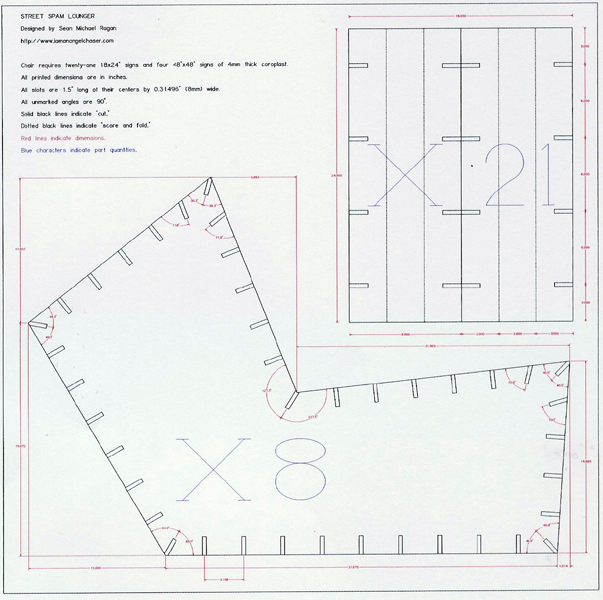[2002-01-21] Street spam lounger
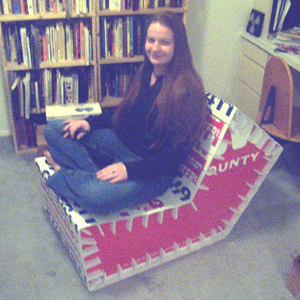
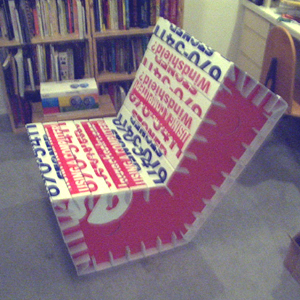
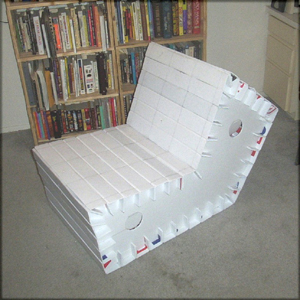

This project happened when one of my passing enthusiasms ran into another: The first was my long-standing interest in designs for what I call "origami chairs"--chairs that fold up from flast pieces of sheet materials, generally cardboard. From patents and other sources, I have collected more than 30 designs for such chairs, and I have occasionally thought of compiling them into a book. The second was sparked by a sticker I saw on a street corner one day pointing me to the website of Citizens Against Ugly Street Spam, an Austin-based organization that has dedicated itself to eliminating obnoxious picket signs in the medians of public roads. Austin has a municipal ordinance making such signage technically "litter," and the founder of CAUSS spends most of his time driving around in a truck, "picking up litter," i.e. ripping signs out of the ground and throwing them away. His website encourages everyone to adopt this behavior, which he calls "sign sharking," for the sake of a neater and less-visually-cluttered Austin.
One of the frequently asked questions on the CAUSS site is whether these picket signs, which are most commonly made of a twin-wall extruded plastic material called "Coroplast," can be recycled. The answer, regrettably, is that they cannot, because they are often composed of different blends of plastics and are not marked for sorting, as plsatic pop and milk bottles are. When I first read this, I'd had some prior experience with Coroplast--for several years starting in the late 80s my Dad was part owner of "US AirCore," a small manufacturing concern in Dallas that made radio-controlled model airplane kits out of the stuff. Coroplast can basically be thought of as "corrugated plastic" or, less accurately, as "plastic cardboard." It can be worked with all the same techniques as cardboard--shearing, die-cutting, scoring, etc.--without suffering from its chief drawback, which is its susceptability to water damage. The US Postal Service uses mail-sorting bins that are made almost entirely of translucent coroplast.
The sign sharks' need for a way to directly recycle Coroplast collided with an idea I'd been nursing from my "origami chairs" project: Why not make chairs that fold up out of Coroplast? Even better, why not make chairs that fold up out of used Coroplast, which can be freely (or cheaply) had, and would otherwise end up in the landfill? Unlike chairs made folded from cardboard, Coroplast chairs are water and stain-proof, and can be cleaned with common household cleansers. They can safely be used outside, although exposure to the UV radiation in direct sunlight will eventually cause the plastic to degrade and crumble.
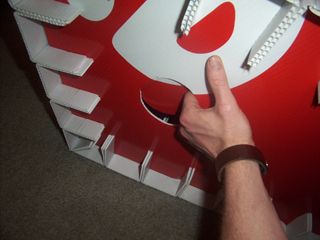
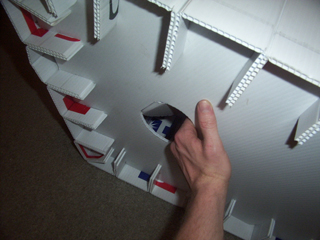
Coroplast signs are printed on pre-cut blanks, which are sold in a few standard sizes. The two most common are 18 x 24" (for picket signs) and 48" x 96" (for fence signs). The larger, 48 x 96" signs are much less common than the smaller pickets, but are relatively plentiful around election time, when everyone from the sanitation commissioner to the President has his or her name printed on one and stuck up prominently beside the road. The street spam lounger uses more than 95% of the material from 21 of the picket-sized signs, and more than 50% of the material from 1 of the "election" signs. There are only two different part blanks--one for the picket signs that form the "skin" of the chair, and one for the election sign which makes the structure. There are 41 skin pieces and 4 structural "bulkhead" pieces, and although that may seem like a lot, they are entirely interchangeable within each set.
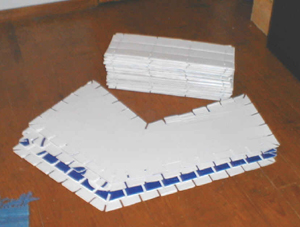
What's more, the parts are designed such that the finished chair may be constructed with either the printed or (by reversing the scores) the blank side of the original signs to the exterior. In the first case the results is a "motley" chair, with bits of the original signage visible all over, and in the second, in a "plain" chair, which displays only the clean backs of the signs. Although white is by far the most common color for street spam Coroplast, it is not uncommon to find it in bright yellow or even red. These "natural" variations in the starting material may be used to good visual effect in the finished chair.
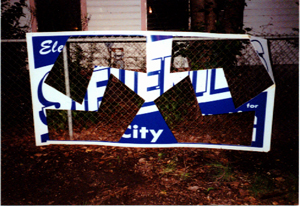
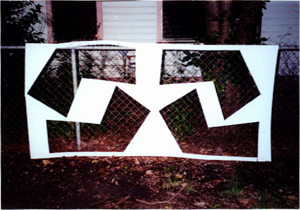
The profile of the chair was adapted from page p.25 of James Hennesey and Victor Papanek's Nomadic Furniture 2, in that the seat and back of the street spam lounger may be reversed by rolling the chair around its lower-rearmost corner. This allows a single chair to provide seating at two different heights--17" for "task" seating and 12" for "lounge" height. The general construction of the chair, with a number of twice-folded rectangles interslotted with large "baffle" pieces that form the profile, is derived from European Patent Office number 0323319 A1, which may be accessed here. When executed in cardboard this construction allows great versitility of design (at least in the shape of the profile), but suffers because of the large number of small pieces it requires to assemble. When executed in recycled coroplast, however, this drawback becomes an advantage--a large number of small pieces are what is available in the raw material itself--and the end, recycling used Coroplast, is only better served by using lots of them. It is a rare exception to Occam's Razor--in this case what may be done with fewer is not necessarily vain if done with more.
As of October 2004, a flurry of interest in this page has prompted me (finally) to prepare plans for the construction of the street spam lounger. First, a couple of points:
To begin with, construction of one of these chairs by hand is extremely labor-intensive. The ideal production is by die-cutting on a press. Signs could be bought for a small bounty at a central location equipped with the proper tooling. The chair pieces would then be stamped, packaged, and sold or otherwise distributed, to be finally assembled by the end user. It is, of course, possible to make your own using nothing more than a yardstick and a boxcutter. It is, however, very boring to do so.
Also, owing to the tedium of hand-cutting, only one prototype of the steet spam lounger has been manufactured to date. The plans presented here are essentially the same, but small improvements have been made based on lessons learned from the prototype. The most notable of these is the doubling-up of internal bulkheads. Whereas the original prototype used 4 single thickness of 4mm coroplast as bulkheads, these plans call for 4 double thickness of 4mm coroplast. Also, the handhold-cutouts on the sides of the bulkheads have been eliminated, as they were found to be unnecessary in practical use. I have not attempted to build a prototype to these specifications. I cannot imagine why it wouldn't work, but problems have a way of springing up unforeseen. I would love to hear from anyone who undertakes to make a chair using these plans.
The plans are also available as a .DXF file, for you CAD types, and as a scalable vector graphic (SVG).
Construction proceeds as follows:
- Obtain twenty-one (21) 24x18" coroplast signs, 4mm thick, with the corrugations running parallel to the long side of the sign, and EITHER two (2) 48x96" signs, also 4mm thick, OR four (4) 48x48" signs of the same thickness.
- Cut and fold the 21 small signs according to the small blank on the upper right of the plan. Fold away from the side you want to show in the finished chair. You will produce 42 identical folded pieces, 41 of which are required to make a single chair. Save the extra piece until the end and throw it out or save it for the next chair.
- Cut up the large signs to make 8 of the large "bulkhead" pieces. It takes 48x48" of material to cut two bulkheads. These will be doubled up in the final construction.
- Assemble the chair by slotting together first at the corners of the bulkheads, and then working your way inwards.
This design could probably be improved in many ways. One side might be made longer by one unit, for instance, so that an even 21 small signs are needed for a single chair, without the odd piece leftover. The profile of the bulkhead might also be changed so that there might be less wastage of material in the "large" sign. In spite of the nonsense I said above about Occam's Razor, if the chair is to be mass produced, it should strive to be as efficient in its use of materials as possible, in order to maximize profit/benefit per unit materials cost. This is an imperative even if the cost of the material is very low, as in this case. Some energy spent on improving the looks of the thing couldn't hurt, either.
last modified 2004-10-21
